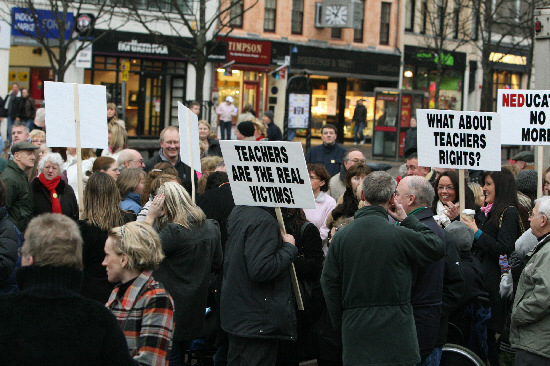A former Dundee maths teacher who fought for two years to have his conviction for assaulting pupils quashed has welcomed new government guidelines on how pupils can be restrained.
Mike Barile was granted an absolute discharge at the High Court in Edinburgh last month, ending a two-year battle to clear his name.
The former Lawside Academy teacher was found guilty after trial of assaulting a boy by grabbing hold of the front of his shirt and threatening him, and assaulting another boy by placing his arm across the boy’s chest to prevent him from leaving the classroom, in 2008.
Now children’s secretary Ed Balls has given teachers clear rules on when the use of force is acceptable.
Although education is a devolved issue, Mr Barile said the announcement sends a clear signal to teachers that they will have more support.
At the conference of the National Association of Schoolmasters/Union of Women Teachers, Mr Balls said unruly pupils can be controlled by force if they seriously disrupt lessons or refuse to leave class.
Guidance from the Department for Children Schools and Families says there are several instances when teachers can restrain pupils, including when pupils are fighting or when they attack a teacher or another student.
Mr Balls said that in extreme circumstances teachers can use “restrictive holds.”
“We are issuing new guidance today to make things really clear,” said Mr Balls.
“Sometimes there is a myth that the right policy is to have no contact at all, but that is ridiculous.
“If there is a fight going on, if teachers are worried about children being unsafe, if there is a pupil in their classroom who is refusing to leave, then the law is very clear that teachers can use force in order to make sure there is proper discipline.
“What you can’t do is use force to punish children. We don’t allow children to be hit, to hurt them for punishment, but if teachers need to use force to keep things safe and discipline in the classroom, then they can, they should, and, to be honest, they do every day.”Guidelines essentialMr Barile welcomed the guidelines and said they will help teachers to maintain classroom discipline.
“I think the more guidelines there are, the better it is for everyone,” he said.
“It is essential that there are guidelines like these. It makes it so much more difficult for teachers if they think they won’t be given any support from above.
“It puts them in a real dilemma if they do something and they don’t get that support it makes them look really powerless in front of the children and undermines the authority that they need.”
The NASUWT, the UK’s largest teaching union, also issued a report saying lack of support from school management teams is one of the main causes of stress for teachers, and some have even considered suicide.
That report, based on interviews with teachers and managers, reveals some teachers are suffering from a range of stress-related symptoms including heart palpitations, lack of sleep and depression.
NASUWT general secretary Chris Keates said, the research “highlights the need for access to support, counselling and specific health interventions for the workforce.”
